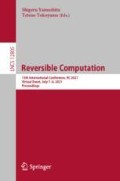Abstract
Quantum computer architectures place restrictions on the availability of quantum gates. While single-qubit gates are usually available on every qubit, multi-qubit gates like the CNOT gate can only be applied to a subset of all pairs of qubits. Thus, a given quantum circuit usually needs to be transformed prior to its execution in order to satisfy these restrictions. Existing transformation approaches mainly focus on using SWAP gates to enable the realization of CNOT gates that are not natively available in the architecture. As the SWAP gate is a composition of CNOT and single-qubit Hadamard gates, such methods may not yield a minimal solution. In this work, we propose a method to find an optimal implementation of non-native CNOTs, i.e. using the minimal number of native CNOT and Hadamard gates, by using a formulation as a Boolean Satisfiability (SAT) problem. While straightforward representations of quantum states, gates and circuits require an exponential number of complex-valued variables, the approach makes use of a dedicated representation that requires only a quadratic number of variables, all of which are Boolean. As confirmed by experimental results, the resulting problem formulation scales considerably well—despite the exponential complexity of the SAT problem—and enables us to determine significantly improved realizations of non-native CNOT gates for the 16-qubit IBM QX5 architecture.
Access this chapter
Tax calculation will be finalised at checkout
Purchases are for personal use only
References
IBM Q. https://www.research.ibm.com/ibm-q/. Accessed 14 Oct 2020
Aaronson, S., Gottesman, D.: Improved simulation of stabilizer circuits. Phys. Rev. A 70(5) (2004). https://doi.org/10.1103/physreva.70.052328
de Almeida, A.A.A., Dueck, G.W., da Silva, A.C.R.: CNOT gate mappings to Clifford+T circuits in IBM architectures. In: International Symposium on Multiple-Valued Logic, pp. 7–12. IEEE (2019). https://doi.org/10.1109/ISMVL.2019.00010
Ash-Saki, A., Alam, M., Ghosh, S.: QURE: Qubit re-allocation in noisy intermediate-scale quantum computers. In: Design Automation Conference, pp. 141:1–141:6. ACM, New York (2019)
Botea, A., Kishimoto, A., Marinescu, R.: On the complexity of quantum circuit compilation. In: SOCS, pp. 138–142. AAAI Press (2018)
Boykin, P., Mor, T., Pulver, M., Roychowdhury, V., Vatan, F.: A new universal and fault-tolerant quantum basis. Inf. Process. Lett. 75, 101–107 (2000). https://doi.org/10.1016/S0020-0190(00)00084-3
Cook, S.A.: The complexity of theorem proving procedures. In: Symposium on Theory of Computing, pp. 151–158 (1971)
de Moura, L., Bjørner, N.: Z3: an efficient SMT solver. In: Ramakrishnan, C.R., Rehof, J. (eds.) TACAS 2008. LNCS, vol. 4963, pp. 337–340. Springer, Heidelberg (2008). https://doi.org/10.1007/978-3-540-78800-3_24
Nash, B., Gheorghiu, V., Mosca, M.: Quantum circuit optimizations for NISQ architectures. Quantum Sci. Technol. 5(2), 025010 (2020)
Nielsen, M.A., Chuang, I.L.: Quantum Computation and Quantum Information: 10th Anniversary Edition. Cambridge University Press (2010). https://doi.org/10.1017/CBO9780511976667
Niemann, P., Wille, R., Miller, D.M., Thornton, M.A., Drechsler, R.: QMDDs: efficient quantum function representation and manipulation. IEEE Trans. CAD 35(1), 86–99 (2016). https://doi.org/10.1109/TCAD.2015.2459034
Niemetz, A., Preiner, M., Biere, A.: Boolector 2.0. J. Satisf. Boolean Model. Comput. 9(1), 53–58 (2014). https://doi.org/10.3233/sat190101
Ranise, S., Tinelli, C.: The Satisfiability Modulo Theories Library (SMT-LIB). www.SMT-LIB.org (2006)
Rintanen, J.: Planning and SAT. In: Handbook of Satisfiability, vol. 185, pp. 483–504 (2009)
Siraichi, M.Y., Santos, V.F.d., Collange, S., Pereira, F.M.Q.: Qubit allocation. In: International Symposium on Code Generation and Optimization, CGO 2018, Vienna, pp. 113–125. ACM (2018). https://doi.org/10.1145/3168822
Wille, R., Große, D., Teuber, L., Dueck, G.W., Drechsler, R.: RevLib: an online resource for reversible functions and reversible circuits. In: International Symposium on Multiple-Valued Logic, pp. 220–225 (2008)
Wille, R., Burgholzer, L., Zulehner, A.: Mapping quantum circuits to IBM QX architectures using the minimal number of SWAP and H operations. In: Design Automation Conference, pp. 142:1–142:6. ACM (2019)
Zhou, X., Li, S., Feng, Y.: Quantum circuit transformation based on simulated annealing and heuristic search. IEEE Trans. CAD 1 (2020). https://doi.org/10.1109/TCAD.2020.2969647
Zulehner, A., Paler, A., Wille, R.: An efficient methodology for mapping quantum circuits to the IBM QX architectures. IEEE Trans. CAD 38(7), 1226–1236 (2019). https://doi.org/10.1109/TCAD.2018.2846658
Author information
Authors and Affiliations
Corresponding author
Editor information
Editors and Affiliations
Rights and permissions
Copyright information
© 2021 Springer Nature Switzerland AG
About this paper
Cite this paper
Niemann, P., Müller, L., Drechsler, R. (2021). Finding Optimal Implementations of Non-native CNOT Gates Using SAT. In: Yamashita, S., Yokoyama, T. (eds) Reversible Computation. RC 2021. Lecture Notes in Computer Science(), vol 12805. Springer, Cham. https://doi.org/10.1007/978-3-030-79837-6_15
Download citation
DOI: https://doi.org/10.1007/978-3-030-79837-6_15
Published:
Publisher Name: Springer, Cham
Print ISBN: 978-3-030-79836-9
Online ISBN: 978-3-030-79837-6
eBook Packages: Computer ScienceComputer Science (R0)

